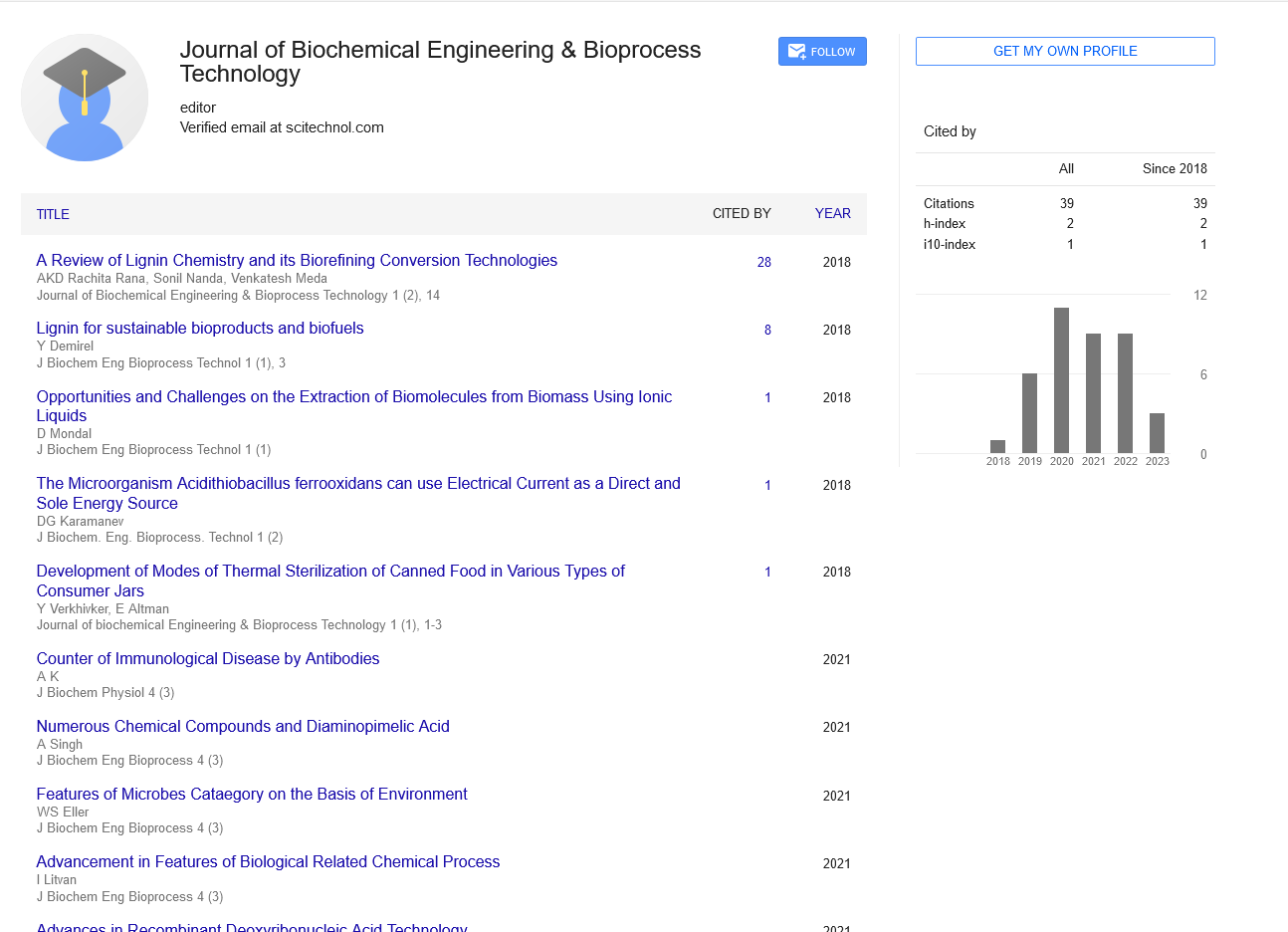Editorial, J Biochem Eng Bioprocess Technol Vol: 1 Issue: 2
Opportunities and Challenges on the Extraction of Biomolecules from Biomass Using Ionic Liquids
Dibyendu Mondal*
Sustainable energy materials and processes research group, Centre for Nano and Materials Science, Jain University, India
*Corresponding Author : Dibyendu Mondal
Centre for Nano and Materials Science, Jain University, Jain Global Campus, Kanakapura Road, Bengaluru-562112, Karnataka, India
E-mail: m.dibyendu@jainuniversity.ac.in
Received: November 22, 2017 Accepted: December 29, 2017 Published: February 19, 2018
Citation: Mondal D (2018) Opportunities and Challenges on the Extraction of Biomolecules from Biomass Using Ionic Liquids. J Biochem Eng Bioprocess Technol 1:1.
Abstract
Biomass is the sustainable resource for natural value-added compounds for instance alkaloid, terpenoid, phenolic, saponin, and several others antioxidants which are of great interest for pharmaceutical, food, fine chemicals and cosmetic industries [1]. Almost 40% of the total drugs manufactured are originated from natural products [2]. Therefore extraction of such small biomolecules from bioresources is of outmost importance. The conventional and commercial extraction processes of such biomolecules possess a number of inadequacies such as laborious and energy intensive extraction process, use of volatile organic solvents and environmental concerns
Keywords: Biomass; Ionic liquids; Biomolecules
Biomass is the sustainable resource for natural value-added compounds for instance alkaloid, terpenoid, phenolic, saponin, and several others antioxidants which are of great interest for pharmaceutical, food, fine chemicals and cosmetic industries [1]. Almost 40% of the total drugs manufactured are originated from natural products [2]. Therefore extraction of such small biomolecules from bioresources is of outmost importance. The conventional and commercial extraction processes of such biomolecules possess a number of inadequacies such as laborious and energy intensive extraction process, use of volatile organic solvents and environmental concerns [3]. An ecofriendly, low-cost and rapid extraction process would benefit to the biomolecules processing industries towards overall economy and greenhouse gas emission. Towards this endeavor ionic liquids (ILs) have shown promise regarding green and rapid extraction point of view [4]. In early 21st century, several air and water stable ILs have been evolved and consequently research on the use of novel ILs as potential solvent for the extraction of value-added compounds from biomass has intensified [5]. In addition to the exceptional solvent properties and environmental benefits compared to common organic solvents, ILs can also swell or dissolve biomass which leads to a better access to the added-value compounds implanted in biomass matrices and thereby enhance the overall extraction efficiency [4,6]. Although ILs can improve extraction efficiency, but biomass dissolution sometime requires long times at elevated temperature besides use of high cost ILs and thereby make the overall process energy intensive [7]. Subsequently, ILs mediated different extraction technologies of bioactive ingredients have been developed [4,8-10]. Considering the high cost of ILs, the later has been confined into the solid matrix to develop IL-assisted solid phase extraction techniques. Due to the ionic character, ILs can interact with electromagnetic fields, thus IL-based microwave assisted extraction of biomolecules in shorter reaction times and higher efficiency has been developed. Apart from the above approaches, IL-based ultrasound assisted extraction; ILbased liquid-liquid extractions are also applied for the extraction of active ingredients from natural extracts. During extraction of some bioactive compounds (which are unstable, labile, thermo-sensitive and susceptible to oxidation in air) precise extraction methodology should be adopted. In this direction a new extraction approach called negative-pressure cavitation extraction has been developed [11] which allow IL-mediated low temperature and inert atmosphere extraction. In general, a wide variety of approaches can be applied in IL-assisted extraction of small biomolecules from natural sources [4]. All these techniques prerequisite some particular conditions and offer benefits compared to each other in the extraction process. Nonetheless, of any kind the methodology applied, ILs have pivotal role towards enhanced extraction performance than conventional molecular solvents. Owing to the distinct properties of ILs to interact with biomolecules via H-bonding, π-π and n-π interaction they could be realised as alternative of molecular solvents in the facile extraction of biomolecules. In literature, extractions of bioactive compounds from biomass are performed on analytical scale, whereas pilot scale studies using IL-based extraction are rare [12]. Moreover, scale-up and isolation of bioactive compounds suffer from (i) the difficulties of separating them from ILs and (ii) the challenge of recovery and recycling of the IL which is mandatory for a future application on industrial scale. Only 18% of the reported studies deal with the real isolation of the biomolecules from IL-solution and recovery of ILs for next batch utilization [13]. Therefore, energy efficient isolation of bioactive compound; IL recycling; and scale-up of the extraction process still remain challenging. Improved approaches for the realtime extraction and separation of the biomolecules employing more benign, non-toxic, low cost and sustainable ILs with recovery and recycling of the ILs need to be developed for their successful implementation in industries.
References
- Newman J, Cragg G (2007) J Nat Prod 70: 461-477.
- Kingston G, (2010) J Nat Prod 74: 496-511.
- Simpson K (2000) Solid-Phase Extraction: Principles, Techniques, and Applications, Taylor & Francis.
- Ventura M, Silva A, Quental, Mondal D, Freire G, et al. (2017) J A P Chem Rev 117: 6984-7052
- Plechkova V, Seddon R (2008) Chem Soc Rev 37: 123-150
- Pinkert A, Marsh N, Pang S, Staiger P (2009) Chem. Rev 109: 6712-6728.
- Tang B, Bi W, Tian M, Row H (2012) J Chromatogr B 904: 1-21.
- Passos H, Freire G, Coutinho P (2014) Green Chem 16: 4786-4815.
- Pereira M, Coutinho P, Freire G (2015) R Soc Chem.
- Bogdanov G (2014) Springer.
- Dong L, Fu J, Zu G, Li J (2011) Chem Eng Process 50: 780-789.
- Duan H, Luo M, Zhao J, Wang W, Zu G et al. (2013) Sep Purif Technol 107: 26-36.
- Bucar F, Wube A, Schmid S (2013) Natural product isolation-how to get from biological material to pure compounds, Nat Prod Rep 30: 525-545.
 Spanish
Spanish  Chinese
Chinese  Russian
Russian  German
German  French
French  Japanese
Japanese  Portuguese
Portuguese  Hindi
Hindi 